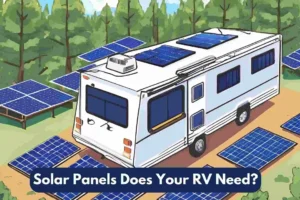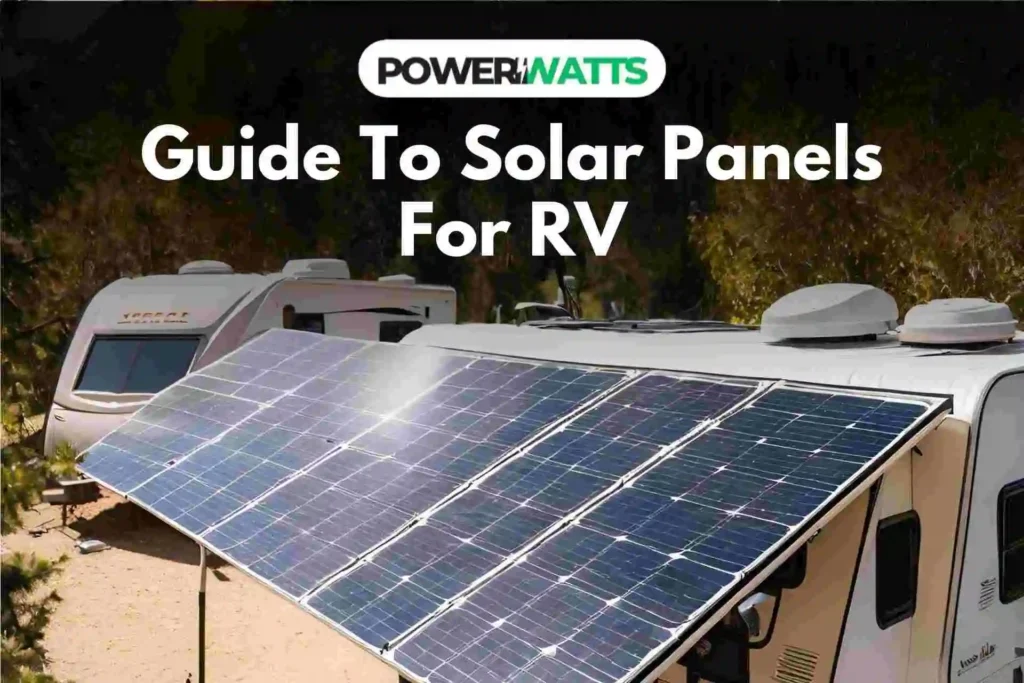Are you ready to welcome a more sustainable way of living and improve your RV travels? Maybe the ideal choice for you is RV solar panels. These creative systems use solar power to generate clean as well as renewable electricity, therefore enabling you to enjoy the great outdoors free from the noise and trouble of conventional generators. Solar panels may improve your RV experience whether you’re boondocking in far-off areas or you just want to cut your dependency on shore electricity.
The basics of solar panels for RV such as is RV solar panels right for you knowing your energy demands, and the tools needed for a successful connection. We will also go over the many kinds of solar panels that are on the market so you may decide depending on
What Are Solar Panels for an RV?
Photovoltaic cells in RV solar panels turn light from the sun into electricity. Usually made of silicon, these panels work by taking in sunlight, which frees electrons that are then caught in a metal circuit to make an electric current. PV panels for RVs come in two main types: monocrystalline and polycrystalline. While monocrystalline panels are more efficient and they cost more.
Polycrystalline panels, on the other hand, are less efficient but less expensive.
Is An RV Solar System Right for You?
It is important to think about whether RV solar is the right choice for your wants and way of life before you jump in.
- If you like to dry camp in remote places without access to shore power, RV solar panels are a great choice for you.
- They want to depend less on noisy and expensive engines.
- Choose energy options that are good for the environment and will last.
- Want the freedom and flexibility to camp for long amounts of time without power
If any of these sound like something that would interest you, an RV solar system might make your trips more fun.
How Do RV Solar Panels Work?
The process of turning sunlight into power that your RV can use is pretty simple. Take a quick look at this:
- Solar panels on the roof of your RV take in sunlight and turn it into electricity.
- The electricity flows through lines to a charge controller. The charge controller controls the current so that your batteries don’t get too charged.
- The charge-controlled power is then used to charge the batteries in your RV, which store energy for later use.
- You can use the 12V DC power that the batteries store to power your RV’s lights, tools, and gadgets.
- You can change the 12V DC power to 120V AC with a transformer if you need it for bigger items.
Now, You’ll be better at how RV solar panels work that meets your needs if you understand this easy process.

How Many Solar Panels Does Your RV Need?
How many solar panels you need for your RV varies on a number of things, such as
- The size of your RV and the number of appliances you plan to power
- The amount of sunlight your location typically receives
- Your daily energy consumption and storage requirements
A 100-watt solar panel can usually make 8 amps per hour, and most RVs can get by with at least three of them. But it’s important to figure out how much energy you actually need to make sure you have enough sun power and battery storage.
Steps for Connecting RV Solar Panels to Your Batteries
To connect your RV solar panels to your batteries then do the following:
- Put your RV’s solar panels on top of it.
- Put the charge controller inside the RV as close to the batteries as you can.
- Connect the solar panels to the RV’s wires and then to the charging device. (If these are close to your batteries, you can run your wires through a refrigerator vent or through the holes where the water comes in. If not, you can drill a hole in the roof of your RV to run your lines. (Make sure to cover and seal any holes you make.) The lines for this run should have a switch or circuit breaker put on them.
- Hook up your charge controller’s wires to your battery bank. These lines should have a fuse put on them that is a little bigger than the charge controller’s rated current.
- The solar panels for RV are not yet linked to the charge processor, but the system is fully set up at this time.
- It’s important to double-check all the wiring to make sure the polarity (positive and negative) is right before making the final connection. You can connect the solar cells to the charging device once you’re sure you’re ready. To avoid a spark, you should do this at night or with a blanket over the solar cells.
- You can skip this step if you don’t want to but if you do and you’ll need to put an inverter inside your RV as close to the batteries as possible and connect the right wires to it.
Please note that you do not need to unplug the converter in your RV if you are connecting your solar panels and controls straight to your battery bank. There will be enough power from both the converter and the solar panels to charge the battery bank.
Find out How Much Energy You Use
Find out how much energy you consume daily. Learn how much electricity each item or appliance you intend to use uses and multiply that by the number of hours you’ll use it while boondocking in your RV.
As an example: You have a 90-watt TV. You expect to watch two hours of TV daily. So 180W/h/day = 90W x 2h.
For each appliance or item you wish to power while boondocking, add the Watt-hours used.
Solar Panel Energy Production and Storage Requirements
Once you know how much energy you use every day, you can figure out how many solar panels and batteries you need. It’s easy to figure out:
Daily energy use (watt-hours) divided by daily peak sun hours equals the required power of solar panels.
For instance, if you use 1,000 watt-hours of electricity every day and get five peak sun hours, you would need a 200-watt solar panel setup (1,000 x 5 = 200).
Aim for at least two to three times your daily energy use in battery storage to make sure you have enough power for dark days and nights. If you cannot understand the total energy storage for your house then Get a Quote.
Solar panel Requirement for RVs
You’ll need the following things to finish your solar panels for RV:
Solar cells:
Based on your budget and energy needs, pick the right size and type.
Charge controller:
This part controls the power from the solar panels so that your batteries don’t get too charged.
Batteries:
These store the power made by the sun so that it can be used later. People often choose AGM or lithium-ion batteries.
Inverter:
An available inverter changes 12V DC power to 120V AC so that bigger machines can use it.
Wiring and connectors:
Make sure that all the parts are safely and effectively connected.
When choosing parts, look for RV-specific goods that are of high quality and will last a long time. Get a Quote and get advice on which products to buy.
Conclusion
Clean, quiet, and affordable RV solar panels power off-grid excursions. Understanding how they function, estimating your energy demands, and choosing the correct equipment lets you harness the sun and enjoy dry camping like never before. A well-designed solar system lets you live without loud generators and restricted shore power and enjoy the peace and freedom of solar electricity.
According to my experience, costs and advantages must be considered when deciding if RV solar panels are worth the investment. I am sure solar panels can boost RV value and make it more interesting to purchasers.
RVers are especially drawn to solar electricity for its ease and environmental advantages. Solar energy lets you camp off-grid for long periods without running out of electricity or needing shore power.
Ready to get into RV solar panels? Get a Quote now and start planning your next solar adventure! However, let solar power make your RV lifestyle more fun and sustainable than ever.


